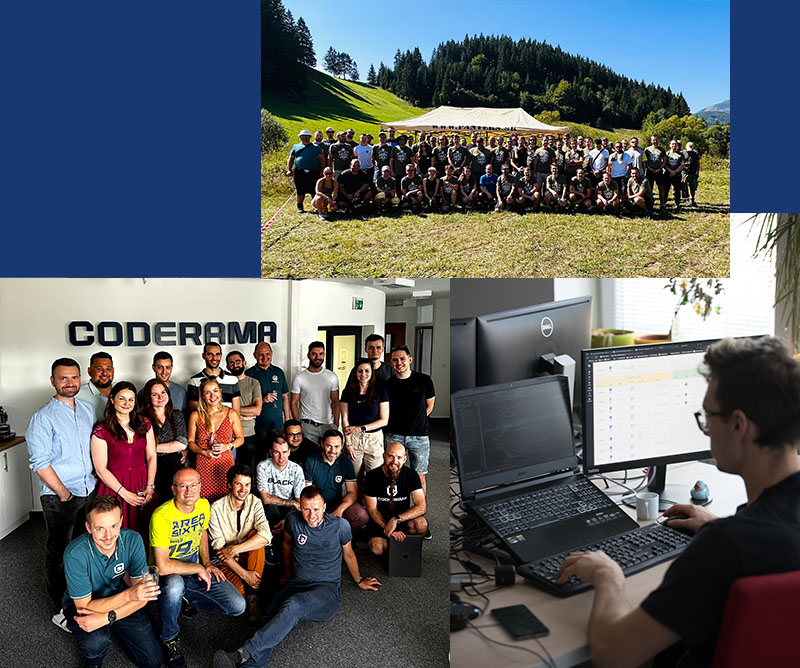Software Development Life Cycle (SDLC): What is it and why is it important?
Alexandra Vaszily|28.03.2023

Software Development Life Cycle, or the Life Cycle of Software Development, is the process of clearly defining goals and phases of software solutions.
This process is important when developing new applications. However, the development of any customised software solution requires not only a strong technical background, but every customer should be informed about the development phases, changes or updates of the software components.
They must also have a clear understanding of everything and ensure that software development moves in the right direction. Communication in this process plays just as important a part in building software than in the choice of technologies. SDLC is a great help for product managers.
Why is SDLC important?
Before the beginning of each development, the development team must define the main tasks and place them in logical sequence. SDLC helps to organise and simplify this process thanks to its simple phases which contain specific tasks. The main advantage of this process is:
- the cycle provides the customer with an overview of developments;
- monitors all tasks and deadlines and their fulfilments;
- helps maintain the already predetermined budget;
- helps adhere to all customer requirements.
SDLC is an essential and very useful set of rules helping to successfully develop software which fulfils all customer requirements and transforms their ideas into a finished product. It is also a handbook for the technical members of the development team. SDLC guides everyone who is involved in the development process, showing a clear plan how to accomplish goals and what resources are needed for this.
The life cycle of software development consists of 6 main stages:
1st stage: Planning and analysis
The first phase of SDLC consists of two parts: the planning phase where the client’s or interested parties’ requirements are collected, and the requirements analysis phase where the feasibility of product creation, revenue potential, production costs, user needs, etc, are examined.
No project can start and successfully develop without a plan. You can use a feature prioritisation framework that takes into account software/update value, costs, building time, and other factors to make right decisions on what to build, what not to build, and what to build first.
Planning clearly helps mainly to define the scope, goals and purpose of the new system, calculate costs of its production or establish the project schedule and create a project team. Additionally, this phase points out the main risks and potential problems that may arise during the software development process. An effective outline and schedule will thus help catch problems even before they negatively affect a given project.
Analysis – this is a key phase in the software development phase. This is the most important part because this is where all the client’s information and business requirements are collected so that we are able to look at them in a wider context. All business needs, requirements and demands are later turned into tasks for developers.
After defining the basic requirements for a software solution, specialists create a plan of the necessary functions which should be implemented in order to meet all the client’s requirements. The result of this phase is a specification or document that dictates and describes all software requirements.
2. Design
The design phase is the phase where you actually put pen to paper. The original plan and vision are developed into the basic structure of software, including system design, programming language, template, platforms for use and application security measures. You can also create at this phase a flowchart to see how the software reacts to user actions.
In most cases, the design phase consists of the development of a prototype. By creating a pre-production version of the product, the team is given the chance to visualise what the product will look like and make changes without having to go through the difficulty of code rewriting.
During this phase, developers outline the aspects:
- Architecture – practices, the overall design and use of any template or standard.
- User Interface – defines the way customers interact with the software and how the software responds to inputs.
- Platforms – defines the platforms on which the software will run, such as Apple, Android, Windows version, Linux or even game consoles.
- Programming – not only the programming language but also problem-solving methods and performing tasks in the application.
- Security – defines the measures taken to secure the application. This can also consist of encryption of SSL traffic, password protection and safe storage of user credentials.
- Network requirements.
- Databases.
The design is the last phase before the actual start of development where customers see the whole structure and prototype, i.e., the first version of the software. This first preview demonstrates the basic vision of how the software will function and what it will look like. This is where customers provide feedback and developers use it for further improvement. It is so much cheaper to change software in this phase rather than in the production phase where it is complicated and time-consuming.
3. Development
In the development phase itself, the development team changes the product specifications and business requirements into the code that builds the product. This phase of the SDLC can take quite a long time. It is important to have a timeline and milestones so that the software developers understand expectations and you can track progress at this phase.
In some cases, the development phase can be combined with the testing phase in which certain tests are performed in order to ensure that no critical errors occur. The programming phase is a little easier thanks to detailed planning.
4. Testing
Before a software product becomes operational, it is important that your quality assurance team tests it and makes sure that it is working well and doing what it should. The testing process can also help to eliminate any major user experience and security issues.
In some cases, software testing can be performed in a simulated environment. Other simpler tests can also be automated.
Types of tests which need to be performed in this phase:
- performance testing
- functional testing
- security testing
- unit testing
- usability testing
5. Deployment
In the deployment phase, your software is delivered to the intended user. You can automate this process and plan the deployment depending on the type. The last stage of development is the deployment or implementation of the finished solution when the software is available to the end users.
The implementation process is also managed according to the plan which arose in the initial phase of the project. If, for example, you deploy only the update feature, you can do so with a small number of users.
However, the deployment of new software can sometimes be tricky. One such example is updating an entire company’s database to a newly-developed application. Because several other systems use the database, integrating a similar update may require more time and effort than usual.
6. Maintenance
If you follow the waterfall structure of the software development process, the maintenance stage is the last stage of the SDLC. The industry, however, is moving towards a more agile approach to software development where maintenance is just a stage for further improvement.
In the maintenance phase, users can find mistakes and errors which were overlooked in the previous testing phase. These mistakes should be fixed in order to improve user experience and user retention. In some cases, it could mean returning to the first phase of the software development life cycle.
The maintenance phase ensures that your new software will always be modern and updated on time. It will also allow you to add new functionalities so that you will always be a step ahead of the competition.
SDLC phases can also be restarted for any new functions you may want to add in the next version/update.
In conclusion
The goal of the SDLC Model is to analyse and improve the building process of new software. It creates a scalable view of the project, from day-day coding to managing the schedule itself. It helps to control the responsibility of all the required functions in different phases of the project, but mainly to sort out tasks and categorise.
Each step in the process should be taken carefully and thoroughly because only then can the process lead to successfully launching the new software solution on the market. However, the phases of the software development cycle vary depending on the requirements of a particular company and business industry. The SDLC can thus be changed or expanded according to the needs of specific customers.

